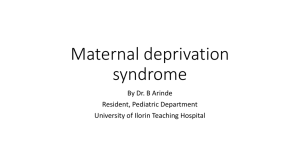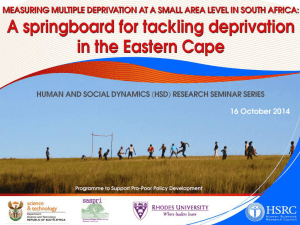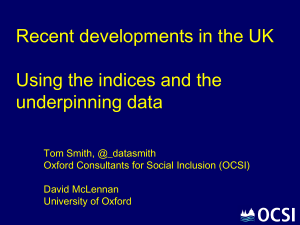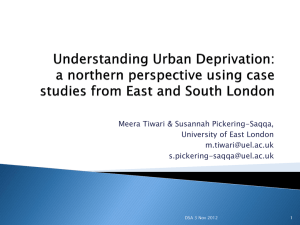Analysing data using webGIS: The Office of National Statistics
advertisement
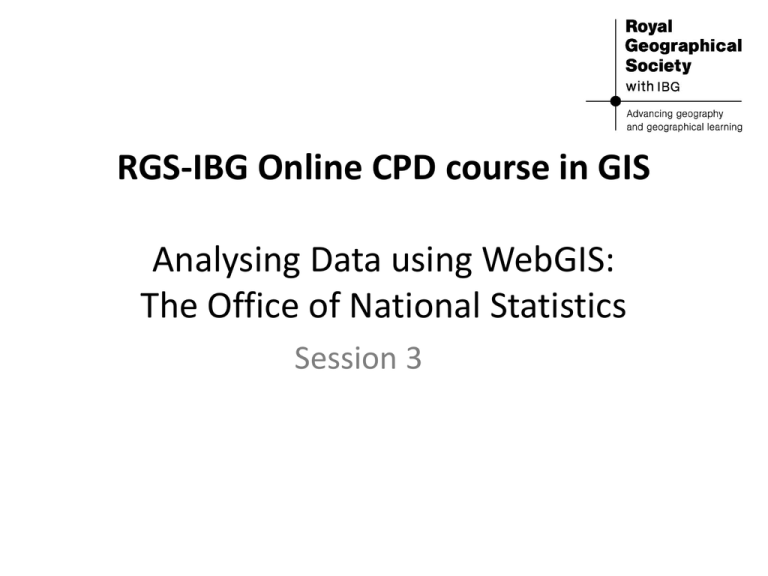
RGS-IBG Online CPD course in GIS Analysing Data using WebGIS: The Office of National Statistics Session 3 In this exercise you will become familiar with a number of concepts. The first is WebGIS. These are online GIS applications which in most cases are excellent data visualisation tools. Their functionality is limited compared to software stored on your computer. During the course we will show you how to use two online GIS applications as well as pointing you in the direction of others, the first is the Office of National Statistics Neighbourhood mapping tool. The second concept is the Neighbourhood Statistics’ geography hierarchy, a hierarchy of areas using Output Areas as building blocks. An Output Area is the smallest level of census area and has a minimum of 100 residents, or 40 households. An Output Area nests into a Lower Super Output Area which nests into a Local Authority which nest into Regions and so on. More information on this has been included at the back of this exercise. Finally you will be mapping the Index of Multiple Deprivation. The Indices of Deprivation are a derived dataset available from the Department of Communities and Local Government for 2001, 2004 and 2007 at the Lower SOA level. The index aims to build a picture of deprivation in an area based on deprivation as measured by the separate dimensions of income, employment, health, education, housing, living environment and crime. More information on this has been included at the back of this exercise. Objectives In this short practical session you will become familiar with the Office of National Statistics’ Neighbourhood mapping tool. The objectives of this session are to create a map and alter it’s appearance. Objectives • Learn how to use an online GIS application • Understand a WebGIS’s interface • Become familiar with exploring data online • Understand the NeSS hierarchy of geographical areas Exercise 1. 2. 3. 4. Open an internet browser and go to http://www.statistics.gov.uk/ Press ‘Neighbourhood’ on the left of the website, this is a site that allows you to download data for specific areas and for the country as a whole. Choose ‘England and Wales’. This webpage provides a number of methods of obtaining data. The ‘Find Statistics for an Area’ allows you to see data based upon a postcode at a variety of spatial scales. On the left is a small link ‘View or Download Data by Topic’ where you can download data for all of England and Wales. In this session you want to use the online mapping facilities provided by the ONS, press the ‘Create a Custom Table, Chart or Map’. If the web page is prompting you to install a small add-on piece of software (Adobe SVG Viewer) please install it using the instructions on screen, if your internet browser does not have this software you will not be able to view the maps. Select an area to study 5. 6. 7. 8. Select the ‘Use a map…..’ option. Press ‘Next’ at the bottom right of your screen. A range of area options are given, stick with the default NeSS Hierarchy, a hierarchy of areas using Output Areas as building blocks (more information given at the end of this exercise). Press Next. On the left of the screen are some options enabling you to select an area. Select ‘Lower Super Output Area’ in step 1 and type an area of your choice (‘Camden’ is used in the video). Press Find. A dialogue box appears (be patient, this can take some time), scroll down to the first Lower SOA and select it. In this example we are using Lower SOAs because we are mapping the Index of Multiple Deprivation which is only available at Lower SOA and Local Authority level, if you were to map Census variable for example you could select a different geography. When the map appears select one of the Lower SOAs by clicking on the map. Make sure it appears in your selections on the right of the screen and that the area is highlighted on the map. Press Next. Select a topic 9. You are now presented with a list of datasets ranging from the census to crime data to air quality data. In this exercise you will map the Index of Multiple Deprivation. 10.Select ‘Indices of Deprivation and Classification’, then ‘Indices of Deprivation 2007 for Super Output Areas’ and finally ‘All Topics…’ so that they appear in the selection box on the right of the screen. Press Next. 11. A table of values will appear, these detail all the attributes (or topics) if the area you selected. However if you look to the left of the screen beneath ‘Neighbourhood’ you will see a chart, an hour glass, a map, etc. Press the map (third button down). 12. The following screen reminds you of your LSOA choice. Press Next. 13. You now have the option of viewing all LSOAs within particular areas. The example in the video all Lower SOAs in the local authority of Camden was chosen, select the same type of analysis. Press Next. 14. Finally a map should load, something like below. 15. Experiment with this map. You are able to: – Change the colour of the classification – Change the number of classes – Change the variable – View the graphical distribution of IMD scores in Camden (or local authority of your choice) using the ‘Graphs’ tab – Add some spatial context with a background map Summary You should now know; • How to map publically provided data online • How to manipulate the map’s appearance NeSS Geography Hierarchy The NeSS Geography Hierarchy is based on aggregations of Output Areas (OAs) and has been introduced to avoid the frequently changing geography of electoral wards. It is also intended to allow a range of different sizes of area at which data can be presented. Output Areas: These were introduced as the smallest units of output for the 2001 Census. In England, Wales and Northern Ireland they have a minimum size of 100 residents and 40 households. In Scotland they have minimum size 50 residents and 20 households. http://www.statistics.gov.uk/geography/census_geog.asp Lower Layer Super Output Area: Lower Layer SOAs are aggregations of OAs. They cover England and Wales and have minimum size 1000 residents and 400 households. The Scottish equivalents are known as 'data zones' and have a minimum of 500 residents. http://www.statistics.gov.uk/geography/soa.asp Middle Layer Super Output Area: These are aggregations of Lower Layer SOAs in England and Wales. They have minimum size 5000 residents and 2000 households. http://www.statistics.gov.uk/geography/soa.asp Local Authority: This represents the most localised areas of local government across the UK. In England: metropolitan districts, nonmetropolitan districts, London boroughs, unitary authorities. In Wales: unitary authorities. In Scotland: council areas. In Northern Ireland: district council areas. http://www.statistics.gov.uk/geography/admin_geog.asp County: Counties are the upper tier of local government in those parts of England with a two-tier structure. They do not exist in Wales, Scotland and Northern Ireland. http://www.statistics.gov.uk/geography/admin_geog.asp Region: Regions are the top-level subdivisions of England. They do not exist in Wales, Scotland and Northern Ireland. http://www.statistics.gov.uk/geography/gor.asp Country: This represents the four UK countries: England, Wales, Scotland and Northern Ireland. http://www.statistics.gov.uk/geography/admin_geog.asp England and Wales: This is included as a commonly used statistical entity. This is because many government departments (including ONS) have a remit covering both England and Wales. Great Britain: This includes the whole of England, Wales and Scotland. United Kingdom: This includes the whole nation state - i.e. England, Wales, Scotland and Northern Ireland. Indices of Deprivation The Indices of Deprivation are a derived dataset available from Communities and Local Government for 2001 and 2004 at OA level. The index aims to build a picture of deprivation in an area based on deprivation as measured by the separate dimensions of income, employment, health, education, housing, living environment and crime. The definition of deprivation underpinning this index is that an area is deprived if it contains a large number or proportion of deprived people. The premise is that deprivation is experienced by individuals and can be accounted for by measuring individual experiences of deprivation. As such the IMD is based on indicators applicable to individuals rather than to the area – for instance, indicators of health are years of potential life lost, comparative illness and disability ratio, emergency admissions, adults suffering from mood or anxiety disorders rather than numbers of hospitals or health clinics in the area. Note that this is one picture of deprivation and is suitable if the focus is on the individuals in an area. A planning approach for example could focus on indicators applicable to the area such as jobs, schools, health care facilities and parks as planners are concerned with the provision of physical facilities and services. For more about deprivation data, look at: http://www.communities.gov.uk/communities/neighbourhoodrenewal/deprivation







